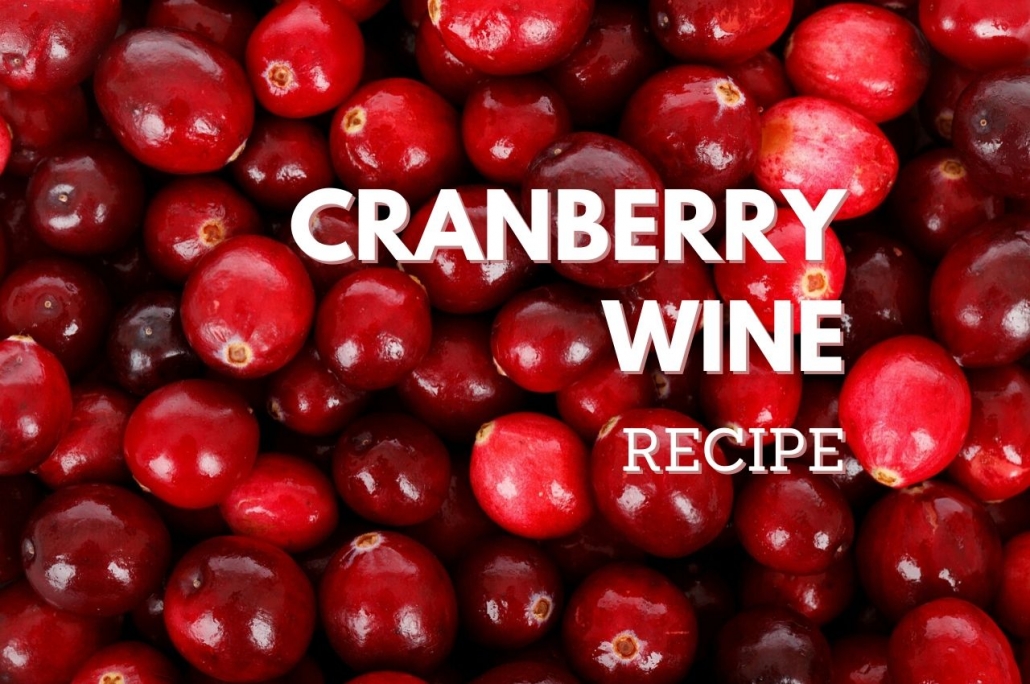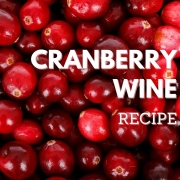Cranberry Wine Recipe – Bright And Fruity

Cranberries are tart, sour and rarely eaten raw, however, fresh cranberries when in season or even frozen cranberries make great wine.
Table of Contents
Cranberry Wine Year Round
Cranberries in my part of the world are most associated with Christmas in the form of cranberry sauce, a sweet jelly. We also have cranberry juice which is sweetened to balance out that tart acidity.
Fermenting cranberries to make wine has the same balancing effect to reign in the tartness and allow the flavour of the cranberries to shine through. Making wine out of cranberries also make a great seasonal drink to bring out when you have people over.
Cranberries For Wine Making
Cranberries are quite a seasonal berry. It gets to a certain point just around November when cranberries start appearing in all the shops. This is, of course, a great time to source cranberries for winemaking.
If you can find them then this is a great time to get them when a lot of other fruits have finished their seasons and you will have plenty of wine-making equipment free.
Fresh or Frozen
Fortunately, a lot of places stock frozen cranberries year-round. Frozen berries are great for wine-making and the cranberries are usually frozen at their peak so you get the best flavour and they are as ripe as they should be.
Freezing the cranberries also helps to break down the cells of the fruit which is great for winemaking. We want to extract the juice, colour and flavour from the berries and the freezing process help this along.
Acidity Is Important For Making Wine
Cranberries are quite acidic, they are one of those fruits like gooseberries that needs sugar or cooking down to really appreciate. This acidity is great for winemaking.
Without acid, wines can taste flat and dull so the natural acidity in cranberries will enhance the wine once it has fermented. Certain fruit wines require the addition of acid in the form of an additive but cranberries are acidic enough on their own.
Preparing The Cranberries
If you are using frozen cranberries bought from a store then all you need to do it thaw the cranberries overnight in a suitable container to catch all the juices.
If you are using fresh berries then you will need to give them a thorough rinse and then pick through them to remove any bad or damaged cranberries. Once you have done that you are good to go.
Cranberry Wine Recipe
Equipment What You Will Need For This Cranberry Wine Recipe – Makes 1 gallon / 4.5 litres
- Large Stock Pot
- Small Fermenting Bucket
- Demijohn
- Masher
- Syphon
- Fine Straining Bag
- Airlock & Bung
Cranberry Wine Ingredients
- 4.5 litres Water
- 1.4 kg / 3lb Cranberries
- 1kg / 2.2lb Sugar
- 400g / 14 ounces Golden Raisins
- 1/4 tsp Tannin
- 1/2 tsp Pectic Enzyme
- 1 tsp Yeast Nutrient
- 1 Campden Tablet
- 1 Sachet Yeast (Lallemand EC-1118 or similar choice)
Cranberry Wine Method
To begin, take the clean and sorted cranberries and coarsely chop them. A food processor will make quick work with this if you have one. It doesn’t need to be too fine just roughly chopped.
Roughly chop the raisins, if you are using a food processor this can be done at the same time as the cranberries.
In a large pan add half the water and begin to heat, stir in all the sugar and slowly dissolve. Take care not to scorch the sugar on the bottom of the pan by stirring. Bring the sugar solution up to a simmer.
While you are waiting for the sugar solution to simmer place the straining bag into a sanitised fermenting bin and add the cranberries and raisins. Secure the top of the bag to contain all the fruit.
Once the sugar solution has simmered for a few minutes remove it from the heat and pour over the cranberries in the fermenting bin. Give everything a good mix together and then add the rest of the water to bring the temperature down.
Add the tannin, yeast nutrient, Campden tablet, give everything a good mix and cover and leave for at least 24 hours. Take a hydrometer reading to get a starting gravity if you wish.
After 24 hours, add the pectic enzyme and pitch the yeast according to the packet instructions, rehydrating if desired. Cover the fermenting bin and attach the airlock and wait for fermentation to begin.
Allow primary fermentation to occur for 7 days gently stirring or swirling the fruit every day. After 7 days remove the straining bag with the cranberries and these can be discarded. Cover the fermenter and allow to ferment for a further 3 days.
3 days after removing the fruit the wine can be racked to a demijohn/carboy leaving the sediment behind. Seal the demijohn with a bung and airlock and all the wine to finish fermentation and start clearing. Take a hydrometer reading to see the progress of fermentation should you wish.
After 3 – 4 weeks in the demijohn the fermentation activity will have eased off and the cranberry wine will be starting to clear. Once the sediment has built up, rack the wine to a clean demijohn leaving the lees and sediment behind.
The wine can now condition and mature in the demijohn for 3 – 4 months or more. Bulk ageing in this way will improve the finished wine. Rack to a new demijohn if sediment builds up.
After 3 – 4 month the wine can be bottled. This is a good time to sample the wine and make any adjustments if necessary. Cranberry wine can be back sweetened if it is too dry, follow the guidance here on how to stabilise and sweeten the wine.
Once bottled it is a good idea to set the wine aside for as long as you can bear. Try a bottle after a few months.




Leave a Reply
Want to join the discussion?Feel free to contribute!